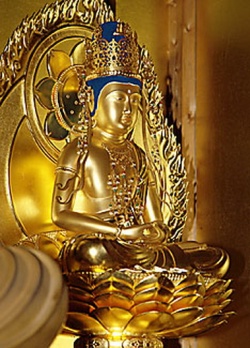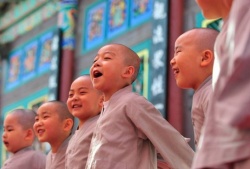Dhutaṅga
Dhutanga (Pali dhutanga "renunciation", known in Thai as "Thudong") is a group of thirteen austerities or ascetic practices most commonly observed by the practitioners of the Thai Forest Tradition of Theravada Buddhism.
Description
All Forest Monks will observe at least one of the dhutanga austerities.
The dhutanga austerities are meant to deepen the practice of meditation and assist in living the Holy Life.
Their aim is to help the practitioner to develop detachment with material things including the body.
The thirteen dhutanga practices
1. Refuse-rag-wearer's Practice (pamsukulik'anga) — wearing robes made up from discarded or soiled cloth and not accepting and wearing ready-made robes offered by householders.
2. Triple-robe-wearer's Practice (tecivarik'anga) — Having and wearing only three robes and not having additional allowable robes.
3. Alms-food-eater's Practice (pindapatik'anga) — eating only food collected on pindapata or the almsround while not accepting food in the vihara or offered by invitation in a layman's house.
4. House-to-house-seeker's Practice (sapadanik'anga) — not omitting any house while going for alms; not choosing only to go to rich households or those selected for some other reason as relations, etc.
5. One-sessioner's practice (ekasanik'anga) — eating one meal a day and refusing other food offered before midday. (Those Gone Forth may not, unless ill, partake of food from midday until dawn the next day.)
6. Bowl-food-eater's Practice (pattapindik'anga) — eating food from his bowl in which it is mixed together rather than from plates and dishes.
7. Later-food-refuser's Practice (khalu-paccha-bhattik'anga) — not taking any more food after one has shown that one is satisfied, even though lay-people wish to offer more.
8. Forest-dweller's Practice (Araññik'anga) — not dwelling in a town or village but living secluded, away from all kinds of distractions.
9. Tree-root-dweller's Practice (rukkhamulik'anga) — living under a tree without the shelter of a roof.
10. Open-air-dweller's Practice (abbhokasik'anga) — refusing a roof and a tree-root, the practice may be undertaken sheltered by a tent of robes.
11. Charnel-ground-dweller's Practice (susanik'anga) — living in or nearby a charnel-field, graveyard or cremation ground (In ancient India there would have been abandoned and unburied corpses as well as some partially cremated corpses in such places.)
12. Any-bed-user's Practice (yatha-santhatik'anga) — being satisfied with any dwelling allotted as a sleeping place.
13. Any-bed-user's Practice (nesajjik'anga) — living in the three postures of walking, standing and sitting and never lying down. Notable Modern Practitioners
Ajahn Mun Bhuridatta and Ajahn Chah

